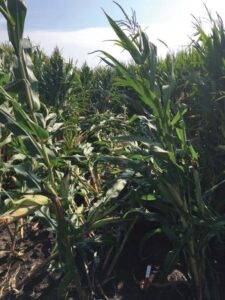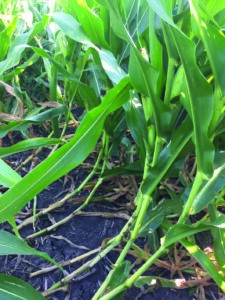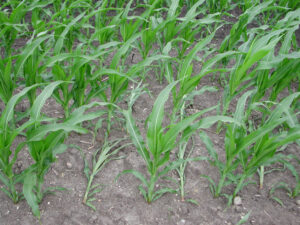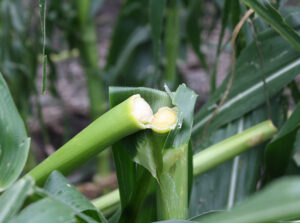- Lodged corn from strong winds (Figure 1) is a common occurrence every year, particularly in the central Corn Belt. The lodging can range from just leaning, to root lodging, to “greensnap,” in which the stalk snaps above a node, in many cases at or below the ear.
- The severity of the lodging and the ability of the corn to recover depends on the growth stage of the plants, the soil moisture, the root mass structure, and the type of corn product planted at the time of the wind event.
- Injury assessment should be delayed at least 4 days after the damage to best determine if the plant may recover.

Figure 1. Lodged corn.
Best-case Scenario
The best-case scenario is for the plant to be leaning or lodged prior to tassel emergence, and for the stalk to be unbroken. While plants may be completely flattened in this scenario, most of the plants can reorient on their own, and there should be little impact on pollination. These plants can begin to straighten themselves in as little as three days.
Moderate-case Scenario
Root lodging usually occurs when high winds coincide with high soil moisture. If most of the root mass loses contact with the soil, the plant will have reduced water and nutrient uptake. The plant often reorients itself if it is in a vegetative stage when root lodging occurs, but the stalk will be bent with a “goose-neck” appearance (Figure 2). If soil moisture remains adequate and the plant has time reorient prior to pollination, yield potential may be reduced only slightly. Leaves may become shaded on plants that cannot reorient vertically, which may reduce photosynthesis. If this occurs close to tassel emergence, the leaves may cover some of the silks, also reducing pollination.
An Ohio study found that when corn plants were artificially lodged greater than 80° at V10, V13, VT, and R3 growth stages, grain yield losses ranged from 5 to 43%. Plants lodged at V10 suffered a 5% yield loss with 2% barren plants, while plants lodged at VT had a 43% yield loss with over 8% barren plants.2 The closer the plants get to tasseling, the less flexible the stalks become, and the greater the chance of pollination being negatively impacted.
Worst-case Scenario
Plants in the rapid growth stage—V4 through tasseling—are most susceptible to “greensnap,” particularly between the V8 and tasseling stages. During this phase, the plant is growing so rapidly that it cannot produce enough lignin—the plant’s structural support protein that functions similarly to the steel mesh added to stabilize concrete—to keep pace with its growth. The resulting lack of lignification at the stalk internodes makes the plant particularly susceptible to breakage (Figure 3). Plants that snap above the harvestable ear can still produce an ear, but since the plant lacks the upper leaves which contribute up to 70% of the photosynthetic capacity needed to fill the ear, yield potential is likely reduced. Greensnap below the ear results in considerable loss of yield potential (Figure 4). Research has shown that corn yield can be reduced by 0.5 to 1% per each percent of the total plants that are broken
or greensnapped.

Figure 2. Goose-necked corn recovering after being lodged.

Figure 3. Greensnapped corn pre-tassel.

Figure 4. Greensnapped corn post-tassel.
